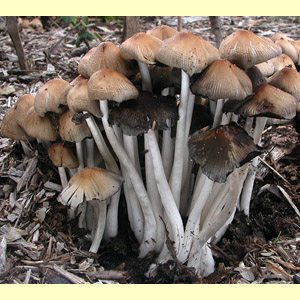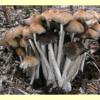
images/Coprinus_broad_sense/Coprinus_micaceus_TM_DSCN4781a.jpg

Identification units
Five identification units that belong to Coprinus as formerly interpreted in a broad sense are keyed out separately. The Coprinus comatus group (Coprinus in a strict sense) belongs in the Agaricaceae, the other units belong in the Psathyrellaceae.
- Coprinus comatus group covers the Australian species of Coprinus in a restricted sense. The genus differs from other species formerly placed in Coprinus by the combination of large fruit-body size, squamulose pileus (with the scales not easily dislodged), the presence of an annulus (often low down on the stipe at maturity), the absence of pleurocystidia and in having a pileipellis that is a cutis, without pileocystidia.
- Coprinellus is distinguished from other members of Coprinus (in the broad sense) by the hymeniderm pileipellis mostly with distinct pileocystidia (although these are absent in some species) and often with an overlying veil of globose elements
- Coprinopsis has a hymeniderm or epithelioid pileipellis.
- Coprinus cordisporus group. This does not belong in Coprinus in the strict sense, but its position in relation to Coprinopsis and Coprinellus has not been resolved.
- Parasola is not truly deliquescent, lacks a veil and has pleurocysitida and a hymeniform pileipellis.
